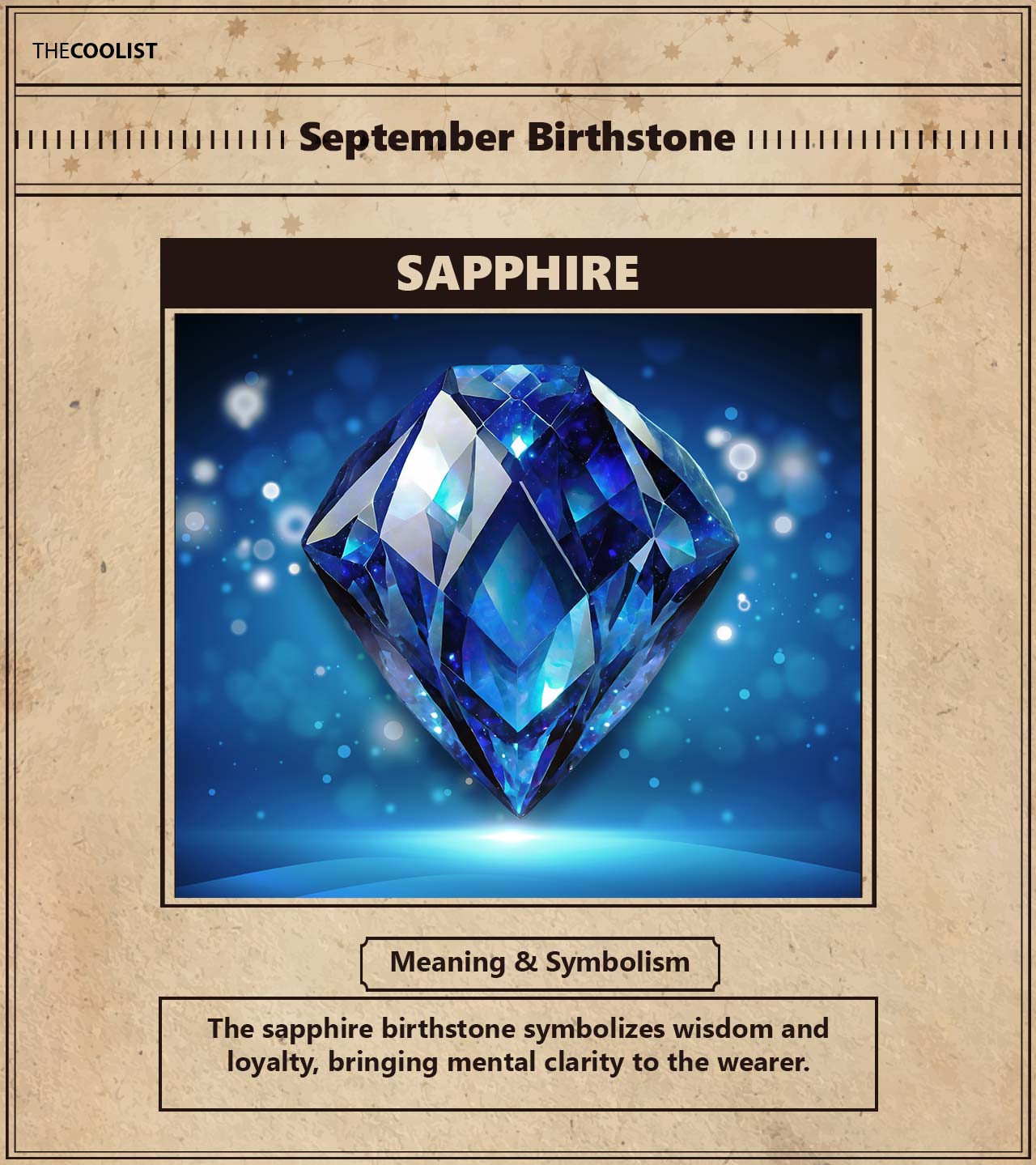The September birthstone is sapphire and embodies mental clarity, royalty, protection, spirituality, and love. Sapphires are revered for their striking deep blue color that resembles the sky’s blue hues. People born in September align with the traits associated with sapphire, offering an aesthetic enhancement and a deeper connection to the stone’s inherent qualities.

Sapphires are esteemed for their protective and spiritual attributes, once believed to guard against harm and negativity while fostering spiritual insight and divine connection. These qualities made sapphires favored among royalty and clergy, symbolizing physical protection and ethical and spiritual purity. Their enduring appeal as symbols of wisdom and integrity is evident in their use in various historical artifacts and royal jewels.
The transition from traditional to modern September birthstones highlights the sapphire’s ascent as the predominant gemstone for this month, moving away from earlier alternatives like chrysolite. This shift reflects the sapphire’s increasing prominence and value in contemporary times, distinguishing it from other gemstones once associated with September.
Below, learn about the sapphire’s meaning, history, and benefits, exploring how this beloved gemstone continues to enchant and inspire.
What does the September birthstone mean?
The September birthstone symbolizes mental clarity, royalty, protection, spirituality, and love. Sapphires are traditionally seen as gems of wisdom and virtue because of their reputation for enhancing mental clarity. This aspect is highlighted in literary references such as Gems and Gem Minerals by Oliver C. Farrington, within a poem that claims the sapphire provides mental clarity.
Sapphires represent royalty and nobility due to their regal blue color, symbolizing power, prosperity, and divine favor. This connection to royalty is evident in their frequent appearance in the crowns and regalia of kings and queens throughout history, marking them as symbols of authority and status.
September’s sapphire birthstones are renowned for their protective qualities, believed to shield against negative energies, envy, and harm. This protective nature positions them as talismans of safety and well-being. Sapphires’ deep blue hue is linked to spirituality and the divine, representing the heavens and fostering a connection to higher realms and spiritual awareness.
Sapphires are a popular choice for engagement rings, symbolizing loyalty, fidelity, and enduring love. Their durability and correlation with commitment make them an ideal emblem for significant relationships. The varied meanings of sapphires, from wisdom and protection to love and spirituality, continue to make them a cherished and meaningful gemstone for those born in September.

What is the difference between modern and traditional September birthstones?
The difference between modern and traditional September birthstones lies in the shift from chrysolite to sapphire. The traditional September birthstone, chrysolite, is a gemstone associated with a yellowish-green hue and is known for bringing prosperity and fostering positive relationships. This traditional type of chrysolite embodies the attributes of warmth, light, and clarity.
Conversely, the modern September birthstone is sapphire, recognized for its rich, deep blue color. Sapphire symbolizes wisdom, nobility, and truth. Over time, sapphire has gained prominence due to its striking appearance and durability. The modern recognition of sapphire as the September birthstone reflects a broader appreciation of different gemstone qualities, from the serene depth of sapphire’s blue to its representation of intellectual clarity and integrity.
What are the alternate birthstones for September?
September boasts a variety of alternate birthstones, including lapis lazuli, agate, and zircon. Lapis lazuli boasts a deep blue color and golden pyrite flecks and is cherished for enhancing wisdom and communication, aligning well with September’s themes. Agate is a diverse form of chalcedony known for its banded appearance. It offers balance, harmony, and protection, embodying qualities that resonate with this month’s transitional energy.
Zircon, specifically its jacinth variant, is heralded for promoting clarity, self-confidence, and spiritual growth. Each gemstone provides unique attributes that complement the traditional September birthstone, catering to a range of preferences and symbolic meanings for those celebrating birthdays in this month.
Is there a September zodiac birthstone?
Yes, there are two September zodiac birthstones with sapphire for Virgo and opal for Libra. Sapphire aligns with Virgo’s energy, a sign known for qualities like analytical thinking, meticulousness, and a deep sense of integrity. Virgos that wear sapphire are believed to amplify these traits, enhancing their natural wisdom and providing clarity of thought. It acts as a symbol of purity and truth, resonating with the Virgo’s pursuit of perfection.
September transitions to opal as the focal birthstone, matching Libra’s balanced and harmonious nature. Known for its play of color, opal is thought to encourage Libra’s artistic flair and sociability, highlighting its inherent charm and desire for balance. Both sapphire and opal are seen as complementary to the unique characteristics of their respective zodiac signs in September, enhancing the distinct qualities of Virgos and Libras.
What color is September’s birthstone?
September’s birthstone is a deep blue. The captivating blue color of sapphires symbolizes nobility, wisdom, and divine favor. This association is rooted in historical and cultural contexts, where blue gemstones were revered and associated with royalty and the heavens. The name “sapphire” itself is derived from the Latin word “sapphirus” and the Greek word “sappheiros,” both signifying the color blue.
While blue is the most traditional and iconic color for sapphires, sapphires occur in a spectrum of colors except red. When sapphires exhibit colors other than blue, they are called fancy sapphires. Despite the range of colors sapphires display, the timeless and quintessential blue shade remains the most celebrated and widely recognized characteristic of the September birthstone.
What is the September birthstone crystal shape?
September’s birthstone comes in the following five cuts to enhance its natural qualities.
- Round: Round-cut sapphires are popular for their classic and timeless appeal. While round cuts are more commonly associated with diamonds, they are also used for sapphires.
- Oval: Oval-cut sapphires combine the brilliance of a round cut with a more elongated shape, creating an elegant and flattering appearance.
- Cushion: Cushion-cut sapphires have a square or rectangular shape with rounded corners, balancing a classic and modern look.
- Princess: Princess-cut sapphires are square-shaped with pointed corners. This cut maximizes the brilliance of the gemstone.
- Pear: Pear-cut sapphires, also known as teardrop shapes, combine a rounded end with a pointed end, creating a shape reminiscent of a droplet.
Sapphire is a variety of corundum and has a hexagonal crystal structure. The basic structure of sapphire consists of aluminum oxide molecules arranged in a repeating hexagonal pattern. This hexagonal crystal system gives rise to several distinctive optical and physical properties. When sapphire is formed in nature, it takes the shape of hexagonal prisms with pyramid-shaped terminations.
What’s the history of the September birthstone?
The September birthstone has a long history rooted in royalty and nobility and represents wisdom. Rulers in ancient Persia believed that the sky’s reflection gave sapphires their blue color, making them a sacred gemstone. For example, Symbols of Magic: Amulets and Talismans by Clifford Lindsey Alderman explains that Charlamagne’s wife possessed a pendant with two large sapphire gems in the center.
September’s gemstone was prominent in ecclesiastical settings, particularly during the Middle Ages and Renaissance. It symbolized purity and wisdom and was often featured in the regalia of clergymen and royalty, signifying nobility and divine blessing. For example, the British Crown Jewels contain significant sapphires, illustrating their regal status.
Sapphires have been celebrated throughout history for their natural durability and brilliance, further enhancing their status as a stone of historical importance and timeless beauty. This connection is mirrored in poetry, where sapphires have long been acknowledged as the birthstone for September, evoking a sense of wisdom and calm. The Jewelers of America’s inclusion of sapphire in their standardized list in 1912 solidified its association with September, marking its ongoing legacy and esteemed position in history. This recognition has firmly established sapphire as a treasured gemstone for those born in September, symbolizing intellect, integrity, and serenity.
Where is the September birthstone found?
The September birthstone is found around the globe, with large deposits in Asia and Africa. Kashmir, Myanmar, and Sri Lanka yield a high number of sapphires. Kashmir is renowned for producing some of the most sought-after and vivid blue sapphires. The mines in this region, particularly in the Zanskar range, have historically produced high-quality gems.
The Mogok Valley in Myanmar has been a significant source of sapphires for centuries and is famed for its deep blue sapphires, including the famed “Royal Blue” stones. Meanwhile, Sri Lanka is a significant source of sapphires. The gem-rich gravel beds in river valleys, especially in Rathnapura, produce sapphires in various colors, including blue, yellow, and pink.
The sapphires that come from Africa are formed in Madagascar and Tanzania. Madagascar manufactures stones in various colors, including blues, pinks, and yellows. The Ilakaka region is particularly famous for its gem-quality sapphires. In Tanzania, the Umba Valley is a significant source of the September birthstone; however, Tanzanian sapphires exhibit a range of colors, from blues to greens and yellows.
Is the September birthstone rare?
No, the September birthstone is not rare. Sapphires are among the most common birthstones due to the production of synthetic gems and the vast sapphire reserves worldwide. However, high-quality, vivid blue sapphires with excellent clarity and significant carat weight are more scarce than commercially produced sapphires. For example, the most valuable and sought-after color for sapphires is deep blue, and sapphires with a pure, vibrant blue hue are rarer than those with secondary tones or lighter shades. Despite the popularity of a rare type of sapphire, lower-quality stone is easy to come by.
September birthstone chart
Below is a chart detailing the core features of the September birthstones.
| September birthstones | |
| Modern | Sapphire |
| Traditional | Chrysolite |
| Zodiac | Sapphire (Virgo) and opal (Libra) |
| Meaning | mental clarity and wisdom |
| Color | Deep blue |
| Historical significance | Used to gain wisdom and express love |
What are the September birthstone personality traits?
The September birthstone personality traits echo the personality of Virgos, the zodiac sign that rules this month. However, the qualities are more geared towards strengthening their positive traits, hence why Sapphires are referred to as the September birthstone.
- Wise: Sapphires are traditionally linked to wisdom, a trait reinforced by the number 9, which symbolizes the month. This association implies that those drawn to or influenced by sapphires will likely exhibit wisdom in their decisions and thoughts, reflecting depth, insight, and a broad understanding of the world around them.
- Loyal: The deep blue hue of sapphires symbolizes loyalty. It suggests steadfastness and fidelity in relationships, indicating that individuals connected to this gemstone are likely to be dependable and committed in their personal and professional bonds.
- Clearheaded: Sapphires represent clarity of thought. This trait indicates that those who resonate with sapphires are likely to be clearheaded, possessing the ability to think objectively, make rational decisions, and maintain a clear perspective in complex situations.
- Brave: The durability and strength of sapphires symbolize courage. This suggests that individuals who favor sapphires might possess bravery, facing challenges head-on and standing firm in the face of adversity.
Are there benefits to wearing a September birthstone?
Yes, wearing a September birthstone offers five benefits of enhanced wisdom, calm emotions, protection against negativity, and boosted intuition. Firstly, it enhances wisdom and intellectual clarity, stimulating mental faculties and improving analytical thinking. Secondly, the blue color of the sapphire is thought to calm emotions, helping to balance feelings and bring tranquility during stress.
Additionally, sapphires offer spiritual protection, shielding against negative energies and facilitating spiritual guidance. This gemstone is also associated with loyalty and commitment, potentially strengthening these qualities in relationships. Finally, sapphires are believed to boost intuition and insight, sharpening instincts and deepening understanding of various situations.
What happens after wearing sapphire?
History and myths surrounding September’s birthstone explain that the wearer is protected after wearing sapphire. Sapphire was thought to protect against poisons and counteract their effect. For example, Gems and Gem Minerals by Oliver C. Farrington remarks on placing a sapphire in a jar with a venomous snake or spider to subdue the threat. This belief underscored the gemstone’s perceived protective qualities against harm and danger.
Moreover, sapphires were historically regarded as potent remedies for fevers. Placing the stone on the heart was believed to alleviate fever symptoms, or soaking it in vinegar and consuming the extract would offer medicinal benefits. These practices reflect the deep trust in the sapphire’s curative powers in ancient times.
Who should not wear sapphire?
People born under Aries, Cancer, Leo, Scorpio, Sagittarius, and Pisces should not wear sapphires. Vedic astrology teaches that gemstones influence the energies associated with different planets, and their impact can vary based on an individual’s horoscope. People should be cautious with sapphires due to Saturn’s challenging interactions with these signs.
Western astrologers often suggest that ascendants in Leo or Aries avoid sapphires due to a potential discord between Saturn and the ruling planets of these signs. However, it’s important to remember that deciding to wear any gemstone, including sapphires, often depends on personal beliefs and preferences.
| Further reading on birthstones | |||||||||||
| January | February | March | April | May | June | July | August | October | November | December | |

